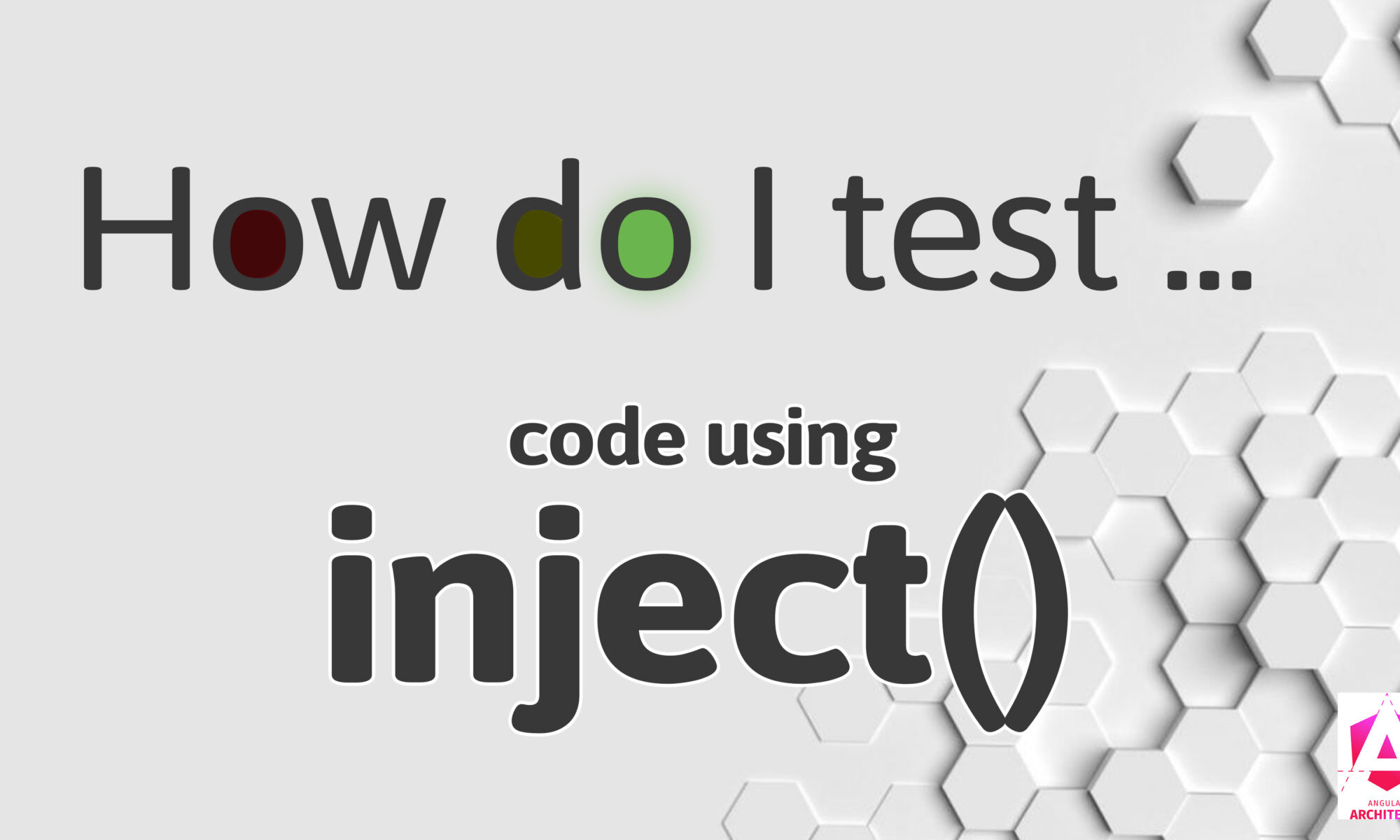This article discusses testing Angular code, which uses the inject function for dependency injection.
If you are more of a visual learner, here's a video for you:
Why inject?
The inject function, introduced in Angular 14, is an alternative to the constructor-based dependency injection. inject has the following advantages:
1. Standardization of Decorators
Decorators have existed in an experimental setting within the TypeScript configuration.
While TC39 has completed the standardization of decorators, all decorator types must be finalized to disable the experimental mode of the TypeScript compiler.

Unlike the constructor, the inject function works without parameter decorators, eliminating potential risks for future breaking changes associated with dependency injection via the constructor.
class FlightSearchComponent {
constructor(
@SkipSelf() // not standardized
@Optional() // not standardized
private flightService1: FlightService
) {}
private flightService2 = inject(FlightService, {
skipSelf: true,
optional: true,
});
}2. Erased Type in the constructor
The type of inject is also available during runtime. With the constructor, only the variable name survives the compilation. So, the TypeScript compiler has to add specific metadata where type information is part of the bundle. This setting is not the default behavior of the compiler.
// TypeScript
class FlightService {}
class FlightSearchComponent {
constructor(private flightService: FlightService) {}
flightService2 = inject(FlightService);
}// Compiled JavaScript
class FlightService {
}
class FlightSearchComponent {
// type is gone
constructor(flightService) {
this.flightService = flightService;
// type is still there
this.flightService2 = inject(FlightService);
}
}3. Class Inheritance
inject is more accessible for class inheritance. With the constructor, a subclass has to provide all dependencies for its parents. With inject, the parent get their dependencies on their own.
// Inheritance and constructor-based dependency injection
class Animal {
constructor(private animalService: AnimalService) {}
}
class Mammal extends Animal {
constructor(
private mammalService: MammalService,
animalService: AnimalService
) {
super(animalService);
}
}
class Cat extends Mammal {
constructor(
private catService: CatService,
mammalService: MammalService,
animalService: AnimalService
) {
super(mammalService, animalService);
}
}// Inheritance via inject
class Animal {
animalService = inject(AnimalService);
}
class Mammal extends Animal {
mammalService = inject(MammalService);
}
class Cat extends Mammal {
catService = inject(CatService);
}4. Type-Safe Injection Tokens
Injection Tokens are type-safe.
const VERSION = new InjectionToken<number>('current version');
class AppComponent {
//compiles, although VERSION is of type number
constructor(@Inject('VERSION') unsafeVersion: string) {}
safeVersion: string = inject(VERSION); // fails 👍
}5. Functional Approaches
Some functional-based approaches (like the NgRx Store) that don't have a constructor can only work with inject.
Because of these many advantages, inject was the rising star. It almost looked like the constructor-based approach might become deprecated.
At the time of this writing, things shifted a little bit. According to Alex Rickabaugh, property decorators are in Stage 1 regarding standardization. That's why he recommends using whatever fits best and waiting for the results of the TC39.
Time Position: 25:25
https://youtu.be/QtTLZRIVaKk?si=ztN826SvGspWzbd7&t=1521
TestBed.inject
Many tests face issues when the application code switches to inject. One of the main issues is the instantiation. With a constructor-based class, a test could directly instantiate the class, but with inject, that is impossible, and we always have to go via the TestBed.
Whenever dealing with a Service/@Injectable, we can call TestBed.inject from everywhere in our test.
That could be at the beginning of the test, in the middle, or even at the end.
We have the following Service, which we want to test:
@Injectable({ providedIn: "root" })
export class AddressAsyncValidator {
#httpClient = inject(HttpClient);
validate(ac: AbstractControl<string>): Observable<ValidationErrors | null> {
return this.#httpClient
.get<unknown[]>("https://nominatim.openstreetmap.org/search.php", {
params: new HttpParams()
.set("format", "jsonv2").set("q", ac.value),
})
.pipe(
map((addresses) =>
addresses.length > 0 ? null : { address: "invalid" }
)
);
}
}AddressAsyncValidator injects the HttpClient. So we have to mock that one.
There is no need to import or create a component in our TestingModule.
It is pure "logic testing". The test doesn't require a UI, i.e., DOM rendering.
describe("AddressAsyncValidator", () => {
it("should validate an invalid address", waitForAsync(async () => {
TestBed.configureTestingModule({
providers: [
{
provide: HttpClient,
useValue: { get: () => of([]).pipe(delay(0)) },
},
],
});
const validator = TestBed.inject(AddressAsyncValidator);
const isValid = await lastValueFrom(
validator.validate({ value: "Domgasse 5" } as AbstractControl)
);
expect(isValid).toEqual({ address: "invalid" });
}));
});That test will succeed. There are two remarks, though.
First, if AddressAsyncValidator has no {providedIn: 'root'} (only @Injectable is available), we have to provide the Service in the TestingModule:
@Injectable()
export class AddressAsyncValidator {
// ...
}
describe("AddressAsyncValidator", () => {
it("should validate an invalid address", waitForAsync(async () => {
TestBed.configureTestingModule({
providers: [
AddressAsyncValidator,
{
provide: HttpClient,
useValue: { get: () => of([]).pipe(delay(0)) },
},
],
});
// rest of the test
}));
});Second, we cannot run inject inside the test. That will fail with the familiar error message.
NG0203: inject() must be called from an injection context such as a constructor, a factory function, a field initializer, or a function used with
runInInjectionContext.
describe("AddressAsyncValidator", () => {
it("should validate an invalid address", waitForAsync(async () => {
TestBed.configureTestingModule({
providers: [
AddressAsyncValidator,
{
provide: HttpClient,
useValue: { get: () => of([]).pipe(delay(0)) },
},
],
});
const validator = inject(AddressAsyncValidator); // not good
}));
});TestBed.runInInjectionContext
Why would we ever want to run inject in a test? Answer: Whenever we have to test a function which uses inject.
In the Angular framework, that could be an HttpInterceptorFn or one of the router guards, like CanActivateFn.
In the Angular community, we currently see many experiments with functional-based patterns.
A good start might be
https://github.com/nxtensions/nxtensions
https://github.com/analogjs/analog/pull/870
We will stick to native features, though, and test a CanActivateFn:
export const apiCheckGuard: CanActivateFn = (route, state) => {
const httpClient = inject(HttpClient);
return httpClient.get("/holiday").pipe(map(() => true));
};apiCheckGuard is a simple function that verifies if a request to the URL "/holiday" succeeds. There is no constructor in a function. Therefore, apiCheckGuard must use inject.
A test could look like this:
it("should return true", waitForAsync(async () => {
TestBed.configureTestingModule({
providers: [
{ provide: HttpClient, useValue: { get: () => of(true).pipe(delay(1)) } },
],
});
expect(await lastValueFrom(apiCheckGuard())).toBe(true);
}));That will also not work. We get the NG0203 error again.
The solution is TestBed.runInInjectionContext. As the name says, it allows us to run any function, which will run again in the injection context. That means the inject is active and will work as expected.
describe("Api Check Guard", () => {
it("should return true", waitForAsync(async () => {
TestBed.configureTestingModule({
providers: [
{
provide: HttpClient,
useValue: { get: () => of(true).pipe(delay(1)) },
},
],
});
await TestBed.runInInjectionContext(async () => {
const value$ = apiCheckGuard();
expect(await lastValueFrom(value$)).toBe(true);
});
}));
});Although it looks like TestBed.runInInjectionContext provides the injection context asynchronously, that is not true.
The guard calls inject synchronously. If it did it in the pipe operator, inject would run in the asynchronous task and again fail.
Summary
inject comes with many advantages over the constructor-based dependency injection, and you should consider using it.
HttpInterceptorFn and router guards are functions and can only use inject to get access to the dependency injection.
To have a working inject, we must wrap those function calls within Test.runInInjectionContext.
There is also TestBed.inject, which behaves differently. It is only available in tests and we should use it get instances of classes. Regardless, if those classes use inject or the constructor-based dependency injection.
You can access the repository at https://github.com/rainerhahnekamp/how-do-i-test
If you encounter a testing challenge you'd like me to address here, please get in touch with me!
For additional updates, connect with me on LinkedIn, X, and explore our website for workshops and consulting services on testing.
{% embed https://www.angulararchitects.io/en/training/professional-angular-testing-playwright-edition/ %}



